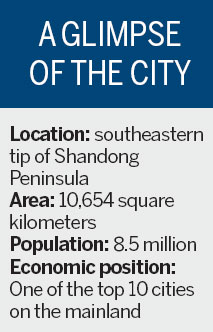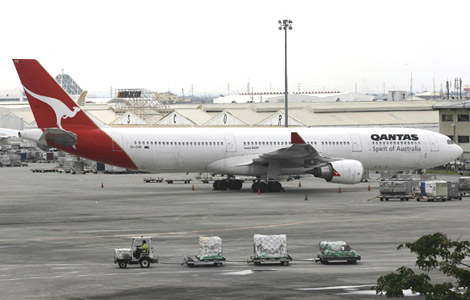Qingdao leads the nation in marine developments
Updated: 2011-10-31 08:04
By Liu Mingjun (China Daily)
|
|||||||||||
|
Qingdao, one of China's most beautiful coastal cities, on the southeastern part of the Shandong Peninsula. Photos provided to China Daily |
Editor's note:
Qingdao has an environment comparable to Silicon Valley's, in California, or India's Bangalore, and is known for its marine resources. It has taken the lead in marine science research and has many industries in related areas.
When the Shandong peninsula's "blue economic zone" was made a part of the nation's development strategy in January this year, the Qingdao government came up with a plan to turn itself into a Blue Silicon Valley and a New Economic Zone on West Jiaozhou Bay.

This is expected to make Qingdao the center of international marine science and technological development, and a national demonstration site, and a force behind the peninsula's blue economic zone.
Qingdao provides major support for Shandong Peninsula's "blue economic zone", thanks to its marine resources, and a solid foundation for its marine economy. And steps are being taken to turn Qingdao into a leader in the marine economy field.

The city has a 711-kilometer coastline, 69 islands, and 49 natural harbors and is just across the Yellow Sea from Japan and South Korea.
Its offshore areas are full of a rich variety of marine life, which contributes to marine industrial development and it held the Olympic Sailing Competition in 2008, which added greatly to its coastal tourism.
The city has 28 marine research institutes, or just over a third of China's total and 20 key laboratories at the ministerial level. It has 19 academics from the Chinese Academy of Sciences and Chinese Academy of Engineering; leading scientists working on 14 of the country's 17 key marine science programs, live in Qingdao.
It is also building major sites for marine innovation, such as the national deep-sea base and national laboratory for marine science and technologies. Since the 11th Five-Year Plan (2006-2010), work on 46 percent of the National High-Tech R&D Program's marine studies has been done at Qingdao universities
Qingdao has had some breakthroughs in artificial breeding technology for kelp, edible seaweed, prawn and scallop production.
It also has emerging industries - beyond the traditional fields such as fisheries, harbor logistics, shipbuilding, and tourism - in marine life and biomedicines that are doing well.
In 2010, Qingdao's marine-related industries had an output value of 168.3 billion yuan ($26.5 billion), an increase of 17.43 percent year-on-year, and 35 billion yuan in marine equipment manufacturing.
Qingdao has become one of the largest ship manufacturers and maritime project developers in Asia, as well as a unique research base for marine biomedicines and chemical products, for China.
Qingdao's port has been ranked 7th in the world, in cargo handling capacity, and 8th, in container handling. The Sino-US, East-Asia, and Asian-Pacific submarine cables all reach Qingdao, which has increased its status as China's communication center.
Its infrastructures, such as the Jiaozhou Bay Bridge, one of the world's longest cross-sea bridge, and the undersea tunnel, have added to its image. A subway is now under construction and it handles a total of 108 domestic and international airlines.
Aiming to be the best
Qingdao is also stepping up efforts in emerging or cutting-edge marine industries and hopes to take the lead in developing a marine economy. It would like to have added value output of 115 billion yuan for its marine industries, by 2015, and 220 billion yuan, by 2020, with annual growth of 14 percent.
The development pattern of the "blue economy" has been described as "one bay, five zones, and multiple support areas" and an economic cluster area for harbor logistics, modern fisheries, seaside tourism, and marine life, has taken shape around Jiaozhou Bay.
Special attention has been given to five areas - the Dongjiakou Port industrial zone; an economic zone on the west side of Jiaozhou Bay; a high-tech zone on its northern side; a modern service zone on its eastern side; and the Aoshan demonstration zone for marine scientific and technological innovations.
A number of support areas will be added, to make full use of the peninsula's advantages and inject some life into the blue economic zone's development.
To make certain that this happens the local government has its focus on developing the more advantageous sectors. First of all, its primary industry, fisheries, will be emphasized to make the city a modern breeding and processing base for aquatic products.
This primary industry is expected to be worth 7 billion yuan in added value output by 2015, and 9 billion yuan, by 2020. It is expected to have 100 oceangoing fishing boats, with an annual fishing capacity of 30,000 tons, by 2015

Qingdao is also looking for a breakthrough in its secondary industries, such as marine biomedicines, shipping equipment, instruments, new marine resources, and marine engineering.
But it is placing equal importance on seawater desalination. Added value output of these secondary industries is expected to reach 46 billion yuan, by 2015, and 88 billion yuan, by 2020.
At the same time, there will be continuous upgrades on tertiary industries, with the focus on harbor logistics, seaside tourism, marine science and education, marine culture and sports, and finance.
Qingdao is looking for added value output for these industries of 62 billion yuan, by 2015, and 123 billion, by 2020. Here, the focus will be on major projects, such as Dongjiakou Harbor and the second phase of Qianwan Bonded Port.
But water sports will not be left out, so that the coastal area can be turned into an international holiday resort.
While making an effort to develop the new economic zone on west Jiaozhou Bay, the city needs to develop modern service industries on the eastern part and increase the blue economic zone's influence.
And it needs to find concrete ways to protect the environment and improve sewage treatment to protect the bay's ecology.
The city also needs to attract more talented people in marine science to come to the blue "Silicon Valley".
These are key factors in the development of a blue economy.
The author is director general of Qingdao's Development and Reform Commission
(China Daily 10/31/2011 page24)
Hot Topics
Libya conflict, Gaddafi, Oil spill, Palace Museum scandal, Inflation, Japan's new PM, Trapped miners, Mooncake tax, Weekly photos, Hurricane Irene
Editor's Picks

|

|

|

|

|

|








